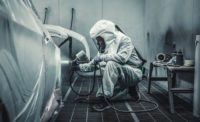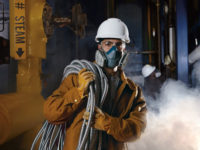Workers in various industries can be exposed to dangerous airborne contaminants. Those contaminants can be as different from each other as construction is to manufacturing and mining is to firefighting. The dangers range from nuisance level dusts to serious, life-threatening exposure, each requiring respiratory products at various levels of protection. Whether you are reviewing a well-established respiratory program or starting completely from scratch, sometimes going back to the basics is exactly what we need!
Know the contaminant
Before we identify the solution, we must first identify the problem. Therefore, the questions we ask when we begin the process of selecting a respirator should focus around the contaminant. It is imperative to educate ourselves about the contaminants we are exposed to, but more importantly, we must know the concentration of that contaminant that is present in the air.
For example, most workers exposed to respirable crystalline silica are typically protected with an N95 disposable respirator. These types of respirators are tested and certified to protect workers up to 500 micrograms of silica per cubic meter, ten times the permissible exposure limit set by OSHA. However, if a worker is issued one of these N95 masks while exposed to an environment with say, 1,000 micrograms of silica per cubic meter, they are now at risk of developing silicosis or other life-threatening illnesses. Even though an N95 disposable respirator would be the most likely option, in this situation, it would not have been enough protection given double the concentration. Instead, this worker would be best protected by a full-face respirator with a quantitative fit test or even a Powered Air-Purifying Respirator (PAPR). Respirators are frequently recommended strictly by the work being done or the contaminant present, when really, it’s the concentration that is the most important factor.
To make the right choice…
To select the correct respirator, we need to know a few things:
- Permissible Exposure Limits (PEL) – Every contaminant has a PEL set by OSHA. Below this concentration, respirators can be worn voluntarily. Above this concentration, respirators are required. OSHA sets these mandatory limits, but we also receive recommendations for lower limits from NIOSH, ACGIH, and others.
- Assigned Protection Factor (APF) – Respirators certified and tested by NIOSH receive an APF that indicates up to how many times the PEL the respirator will protect. For example, a respirator with an APF of 10 will protect the worker up to 10 times the PEL with the appropriate filter/cartridge.
- Immediately Dangerous to Life or Health (IDLH) — When the breathable air in an environment has the potential to adversely affect the lives and health of workers, it is considered an IDLH environment. This could include high concentrations of contaminants — like ammonia at levels above 300ppm or oxygen levels below 19.5% and above 23%. Regardless of the APF of a respirator, once workers are exposed to IDLH respiratory hazards, only a respirator approved to be worn in IDLH environments can be used. This can include a Self- Contained Breathing Apparatus (SCBA) or Pressure Demand Supplied Air Respirator with breathing air cylinders for escape purposes.
- Maximum Use Concentration (MUC) – The MUC is the highest amount of concentration of a specific contaminant with a specific respirator that the worker can be exposed to. Care should be used to make sure whenever the MUC exceeds the IDLH value, an appropriate respirator must be used.
- The PEL of a contaminant multiplied by the APF of a respirator provides the MUC for that worker.
Written programs are mandatory
If respirators are being used in the workplace, a written program is required. These programs should be adaptable and fluid to accommodate any changes that may arise. The written program should address all respiratory hazards at your worksite. Multiple locations can share a program if the locations are similar, but should be site specific if they have their own unique problems and solutions. The written program must be reviewed any time changes are presented from a new contaminant/concentration or a new engineering control, and is recommended to be reviewed at least on an annual basis.
The written respiratory protection program should include information on the following elements:
- Respiratory Selection
- Hazard identification
- Concentrations of contaminants
- Medical Evaluations
- Must be completed prior to first use and fit test
- May be ongoing for specific contaminants
- Fit Testing
- Required initially and annually
- When face or respirator model/size changes
- Training
- Why, when, and where to use
- Respirator limitations
- Procedures for cleaning, storage, inspection, etc.
- Filter/cartridge change-out schedule
- Proper care and use of respirators
- Routine & emergency use
Medical evaluation & fit testing
Prior to selecting a respirator, workers must complete a medical evaluation to ensure they can safely use a respirator. For most applications, this is done once when the worker is first hired. Certain contaminants, such as respirable crystalline silica, may require more frequent medical evaluations. The medical evaluations can often be done quickly and without leaving the workplace by completing an online questionnaire. Contaminant specific medical evaluations are typically done in person as they may involve chest x-rays, pulmonary function tests, and more.
About facial hair
Let’s first address the number one issue that comes up during fit testing: facial hair. You cannot have any facial hair between the skin and the seal of a tight-fitting respirator any time workers are at or above the permissible exposure limits. No exceptions.
This does include disposable respirators, despite dangerous myths that disposable respirators do not require fit testing. OSHA has recently elaborated on the topic of facial hair by stating that the entire sealing surface must be clear of facial hair and that new growth of facial hair may not exceed one day. Loose-fitting hoods and helmets can be used with facial hair as they utilize positive pressure and do not seal against the face.
Once a worker is medically cleared to wear a respirator, they must be fit tested to determine that the respirator fits properly against their face. Once the initial fit test is complete, it should be redone annually, when the respirator itself changes (even to a new size) or any time the worker’s face changes due to weight loss/gain, major dental work, or any other facial structure changes.
Fit testing
Qualitative fit testing includes methods that use a challenge agent like Irritant Smoke, Bitrex©, or Saccharin. These methods require first confirming that a worker is sensitive to these challenge agents. The test then involves exposure to the challenge agent while wearing the respirator with appropriate filters or cartridges. If a worker then smells, tastes, or reacts to one of these challenge agents while wearing their respirator, it can indicate a poor seal or leak.
Quantitative fit testing involves various methods to provide a measurable fit factor for the worker. Quantitative fit test methods provide several benefits for using these more accurate methods. Many industries use these types of testing as a standard with qualitative being the exception. In addition to the increased peace of mind of a more accurate test, faking these tests are also much more difficult compared to the qualitative versions. Finally, one of the most significant benefits would be when using a full-face respirator. Quantitative fit tests provide full-face respirators with an assigned protection factor of 50 compared to a protection factor of 10 with qualitative tests.
Bottom line
In 2018, the 4th most cited OSHA standard was the Respiratory Protection Standard, 1910.134. Many of these citations are violations of what was covered in this article. Selecting the correct respirator, having an updated written respiratory program, and ensuring that medical evaluations and fit testing is completed for all workers are the first steps to an effective respiratory protection program.
Before you consider establishing or reviewing your current respiratory program, ask yourself these 5 basic questions:
- What are the contaminants present in the environment and what is the concentration?
- Are the contaminants above the IDLH value or are oxygen levels below 19.5% or above 23%?
- Is there a written respiratory program and is it up to date?
- Have all workers had a medical evaluation completed?
- Have all workers been fit tested with the appropriate respirator?






